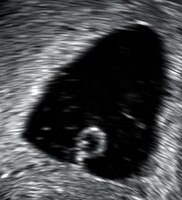
Photo from wikipedia
The aim of this study is to determine the obstetric outcomes in patients with a singleton birth after hysteroscopic division of septate uterus. The data suggest excellent obstetric outcomes for… Click to show full abstract
The aim of this study is to determine the obstetric outcomes in patients with a singleton birth after hysteroscopic division of septate uterus. The data suggest excellent obstetric outcomes for singleton gestation after hysteroscopic division of a septate uterus reaching either the internal or the external cervical os. Septate uterus is a rare Müllerian anomaly with major impact on reproductive outcomes, particularly with a septum over 10mm. Controversy still exists over the need for surgical correction of the septum due to conflicting data on outcomes, particularly in women with histories of good obstetric outcomes and incidental septum findings. Placental location in relation to the septum may account for such conflicting reports. Most data on reproductive outcomes after hysteroscopic surgical correction combine both septate and subseptate uteri. There is limited published data on obstetric outcomes after hysteroscopic surgical correction of septate uteri, especially septate uteri reaching the external os. This retrospective cohort study included 107 patients with infertility and/or recurrent pregnancy loss (RPL) who received treatment between 2002 -2019. The study group included 24 patients with a singleton birth after hysteroscopic correction of septate uterus (Class Va; ASRM classification) that was diagnosed on trans-vaginal 3D ultrasound. The control group included 83 patients with a singleton birth who had normal endometrial cavity on hysteroscopy during the same period of time, before starting treatment. This study was conducted at an infertility clinic affiliated with a teaching hospital. In the study group the septum reached the internal or the external cervical os in 14 and 10 patients respectively. After hysteroscopic correction, all patients were offered various infertility treatments depending on the underlying etiology. The inclusion criterion in this study was to have a singleton birth after hysteroscopy. Demographic and clinical data and obstetric outcomes were compared between the two groups. There was no significant difference in mean age, infertility duration, infertility type and incidence of male infertility or ovulatory disorders between the two groups. There was a significantly higher BMI (0.048), and a higher incidence of history of miscarriage (P=0.002) and history of RPL (P=0.017) in the study group. There was significant lower incidence of tubal factors infertility (P=0.005) and endometriosis (P=0.03) in the study group, therefore there was higher incidence of spontaneous conception (70.8% vs 19.3%; P=0.000) and lower incidence of conception with IVF-ET (20.8% vs 66.3%; P=0.000) in the study group compared to the control group respectively. There was significantly higher incidence of prophylactic cervical cerclage (17.4% vs 0%; P=0.000), and delivery by CS (69.6% vs 41.2%; P=0.019) and lower incidence of vaginal delivery (30.4% vs 58.8%; P=0.019), in the study group compared to the control group. There was no significant difference in gestational age in weeks (38.3 + 1.8 vs 38.6 + 2.0), newborn birth weight in grams (3173.9 + 630.0 vs 3202.1 + 555.6), incidence of premature birth (12.5% vs 12.2%), or other obstetric complications (25% vs 17.6%) between the study and the control groups respectively. For premature births, mean gestational age was 34.3 + 0.47 and 34.6 + 1.2 weeks in the study and control groups respectively. A retrospective study has its own inherent bias. Furthermore, the small sample size is explained by the fact that a septate uterus is a rare anomaly leading to difficulties finding cases and organizing a prospective study to achieve a larger sample size. A multicenter prospective study is needed. Regardless of whether the septum reached the internal or external os, there were excellent obstetric outcomes in singleton gestations after hysteroscopic correction of septate uteri. There was no increased risk with septate uteri involving the cervix. Hysteroscopic surgical correction should be the treatment of choice for patients with septate uteri. Not Applicable
Journal Title: Human Reproduction
Year Published: 2021
Link to full text (if available)
Share on Social Media: Sign Up to like & get
recommendations!